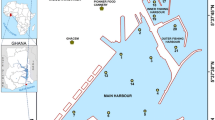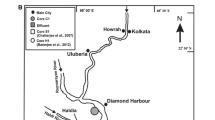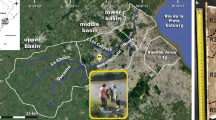Abstract
The speciation and mobility of some selected trace metals (As, Cu, Mn, Pb and Zn) in sediments with depth was investigated in the Cam River-mouth (Vietnam) by collecting sediment cores and analysing porewater and sediment composition, complemented with single (ammonium-EDTA) and sequential (BCR 3-step) extractions and mineralogical analysis (XRD). All trace metals show overall decreasing trends with depth in porewater as a result of anthropogenic input in upper sediment layers. High porewater concentrations of As, Mn and Pb in oxic and suboxic sediment layers may result in groundwater pollution. Sediment-bound Pb and Mn dominate in the reducible and the acid-soluble fraction, respectively, while Cu and Zn distribute rather evenly between four extracted fractions. The porewater metal speciation, as predicted by a geochemical model Visual MINTEQ version 3.0, indicates that the toxicity of Cu, Mn, Pb and Zn (presented by the proportions of free metal ions) decreases with depth, while the toxicity of As increases when As(III) becomes more abundant. The dissolved concentrations of trace metals are not only controlled by the precipitation/dissolution of discrete hydroxide/oxide, carbonate and phosphate minerals, but also by sorption processes on major sorbents (i.e. As on goethite, and Mn and Zn on calcite and dolomite). Sulphide minerals do not show any control even in the anoxic zone most likely because of the low concentration of sulphur.






Similar content being viewed by others
References
Aria A, Douglas BK, Gary PC, James AD (2006) Kinetics of sorption and abiotic oxidation of arsenic(III) by aquifer materials. Geochim Cosmochim Acta 70:533–547
Baeyens W, Monteny F, Leermakers M, Bouillon S (2003) Evaluation of sequential extractions on dry and wet sediments. Anal Bioanal Chem 376:890–901
Canavan RW, Van Cappellen P, Zwolsman JJG, van den Berg GA, Slomp CP (2007) Geochemistry of trace metals in a fresh water sediment: field results and diagenetic modeling. Sci Total Environ 381:263–279
Cappuyns V, Swennen R (2004) Secondary mobilisation of heavy metals in overbank sediments. J Environ Monit 6:434–440
Cappuyns V, Swennen R (2007) Classification of alluvial soils according to their potential environmental risk: a case study for Belgian catchments. J Environ Monit 9:319–328
Carroll S, O’Day PA, Esser B, Randall S (2002) Speciation and fate of trace metals in estuarine sediments under reduced and oxidized conditions, Seaplane Lagoon, Alameda Naval Air Station (USA). Geochem Trans 3(10):81–101
Du Laing G, Rinklebe J, Vandecasteele B, Meers E, Tack FMG (2009) Trace metal behaviour in estuarine and riverine floodplain soils and sediments: a review. Sci Total Environ 407:3972–3985
Gao X, Chena S, Long A (2008) Chemical speciation of 12 metals in surface sediments from the northern South China Sea under natural grain size. Mar Pollut Bull 56:770–797
Gismera MJ, Lacal J, Silva PD, Garcia R, Sevilla MT, Procopio JR (2004) Study of metal fractionation in river sediments. A comparison between kinetic and sequential extraction procedures. Environ Pollut 127:175–182
Hlavay J, Prohaska T, Weisz M, Wenzel WW, Stingeder GJ (2004) Determination of trace elements bound to soils and sediment fractions. Pure Appl Chem 76(2):415–442
Ho HH, Swennen R, Cappuyns V, Vassilieva E, Neyens G, Rajabali M, Tran TV (2013) Assessment on pollution by heavy metals and arsenic based on surficial and core sediments in the Cam River-mouth, Haiphong province, Vietnam. Accepted for publication in the soil and sediment contamination an International Journal 22(4)
Hoang TH, Bang S, Kim KW, Nguyen MH, Dang DM (2010) Arsenic in groundwater and sediment in the Mekong River delta, Vietnam. Environ Pollut 158:2648–2658
Jambor JL, Blowes DW (1998) Theory and applications of mineralogy in environmental studies of sulfide-bearing mine wastes. In: Cabri LJ, Vaughan J (eds) Modern approaches to ore and environmental mineralogy. Mineralogical Association of Canada, Ottawa, Ontario, Short Course Series, vol 27, pp 367–401
Li X, Shen Z, Wai OWH, Li YS (2001) Chemical forms of Pb, Zn and Cu in the sediment profiles of the Pearl River Estuary. Mar Pollut Bull 42(3):215–223
Marchand C, Alberic P, Lallier-Verges E, Baltzer F (2006) Distribution and characteristics of dissolved organic matter in mangrove sediment pore waters along the coastline of French Guiana. Biogeochemistry 81:59–75
Marchand C, Lallier-Verges E, Allenbach M (2011) Redox conditions and heavy metals distribution in mangrove forests receiving shrimp farm effluents (Teremba bay, New Caledonia). J Soils Sediments 11:529–541
Nguyen TPH, Luu VD (2004) Assessment on anthropogenically-induced contaminant loads into the Nam Trieu Mouth. In: Tran DT (editor in chief) Proceedings of the anniversary of the 45th establishment day of Haiphong Institute of Oceanography, Vietnam, pp 54–63. (Vietnamese)
Prasad MBK, Ramanathan AL, Shrivastav SK, Anshumali SR (2006) Metal fractionation studies in surfacial and core sediments in the Achankovil River basin in India. Environ Monit Assess 121:77–102
Quevauviller Ph (1998) Operationally defined extraction procedures for soil and sediment analysis I. Standardization. Trends Anal Chem 17(5):289–298
Rauret G, López-Sánduz JF, Sahuquillo A, Rubio R, Davidson C, Ure A, Quevauviller Ph (1999) Improvement of the BCR three-step sequential extraction procedure prior the certification of new sediment and soil reference materials. J Environ Monit 1:57–60
Ryu J, Gao S, Dahlgren RA, Zierenberg RA (2002) Arsenic distribution, speciation and solubility in shallow groundwater of Owens Dry Lake, California. Geochim Cosmochim Acta 66(17):2981–2994
Schumacher BA (2002) Methods for the determination of total organic carbon (TOC) in soils and sediments. Office of Research and Development, US Environmental Protection Agency. http://www.epa.gov/esd/cmb/research/papers/bs116.pdf. Accessed 20 Jan 2012
Sharma VK, Sohn M (2009) Aquatic arsenic: toxicity, speciation, transformations, and remediation. Environ Int 35:743–759
Shum M, Lavkulich L (1999) Speciation and solubility relationships of Al, Cu and Fe in solutions associated with sulfuric acid leached mine waste rock. Environ Geol 38(1):59–68
Singh SP, Tack FMG, Verloo MG (1998) Land disposal of heavy metal contaminated dredged sediments: a review of environmental aspects. Land Contam Recl 6(3):149–158
Skrabal SA, Donat JR, Burdige DJ (2000) Porewater distributions of dissolved copper and copper-complexing ligands in estuarine and coastal marine sediments. Geochim Cosmochim Acta 64(11):1843–1857
Skvarla J (1998) A study on the trace metal speciation in the Ružín reservoir sediment. Acta Montan Slovaca 2:177–182
Tack FMG, Verloo MG (1995) Chemical speciation and fractionation in soil and sediment heavy metal analysis: a review. Int J Environ Anal Chem 59:225–238
Tessier A, Turner DR (1995) Metal speciation and bioavailability in aquatic ecosystems. Wiley, West Sussex, PO19 1UD, England
Thums CR, Farago ME, Thornton I (2008) Bioavailability of trace metals in brownfield soils in an urban area in the UK. Environ Geochem Health 30:549–563
US EPA (2007) Framework for Metals Risk Assessment. US Environmental Protection Agency, Washington, DC 20460. http://www.epa.gov/raf/metalsframework/pdfs/metals-risk-assessment-final.pdf. Accessed 20 Jan 2012
Van Herreweghe S, Swennen R, Cappuyns V, Vandecasteele C (2002) Chemical associations of heavy metals and metalloids in contaminated soils near former ore treatment plants: a differentiated approach with emphasis on pHstat-leaching. J Geochem Explor 76:113–138
Vink JPM (2009) The origin of speciation: trace metal kinetics over natural water/sediment interfaces and the consequences for bioaccumulation. Environ Pollut 157:519–527
Yu KC, Ho ST, Tsai LJ, Chang JS, Lee SZ (1996) Remobilization of Zinc from Ell-Ren River sediment fractions affected by EDTA, DTPA and EGTA. Water Sci Technol 34(7–8):125–132
Zerbe J, Sobczynski T, Elbanowska H, Siepak J (1999) Speciation of heavy metals in bottom sediments of lakes. Pol J Environ Stud 8(5):331–339
Acknowledgements
We would like to thank Prof. Noel Vandenberghe, Mr. Rieko Adriaens and Ms. Ria Brepoels from the Division of Applied Geology & Mineralogy (Department Earth & Environmental Sciences) for the grain-size and XRD mineralogical analyses, Prof. Erik Smolders and Dr. Bjorn Dieu from the Division of Soil and Water Management (Department Earth & Environmental Sciences) for the DOC and DIC analysis, and Dr. Solvita Ore from the Department of Chemical Engineering, Catholic University of Leuven (K.U. Leuven) who assisted us in the ICP-MS analysis. This research is supported by the Belgian Technical Cooperation (BTC) through a Ph.D. scholarship and the International Foundation for Science, Stockholm, Sweden and the Organization for the Prohibition of Chemical Weapons, The Hague, The Netherlands, through a grant to Ho Huu Hieu.
Author information
Authors and Affiliations
Corresponding author
Appendix
Appendix
Rights and permissions
About this article
Cite this article
Ho, H.H., Swennen, R., Cappuyns, V. et al. Speciation and Mobility of Selected Trace Metals (As, Cu, Mn, Pb and Zn) in Sediment with Depth in Cam River-Mouth, Haiphong, Vietnam. Aquat Geochem 19, 57–75 (2013). https://doi.org/10.1007/s10498-012-9178-z
Received:
Accepted:
Published:
Issue Date:
DOI: https://doi.org/10.1007/s10498-012-9178-z




